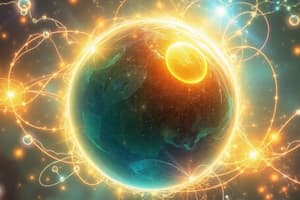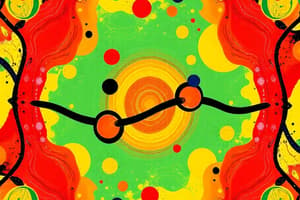Podcast
Questions and Answers
What is a cation?
What is a cation?
A positively charged ion
What is an ion?
What is an ion?
An atom that gains or loses electrons
What is an anion?
What is an anion?
Any atom or group of atoms with a negative charge
How are cations formed?
How are cations formed?
How are anions formed?
How are anions formed?
What are valence electrons?
What are valence electrons?
What is the octet rule?
What is the octet rule?
What is an electron dot structure?
What is an electron dot structure?
What is a halide ion?
What is a halide ion?
What is an ionic bond?
What is an ionic bond?
How many valence electrons does a helium atom have?
How many valence electrons does a helium atom have?
What is the electron configuration of the calcium ion?
What is the electron configuration of the calcium ion?
The octet rule states that in chemical compounds, atoms tend to have __________.
The octet rule states that in chemical compounds, atoms tend to have __________.
How many electrons does nitrogen gain in order to achieve a noble gas electron configuration?
How many electrons does nitrogen gain in order to achieve a noble gas electron configuration?
What is the formula of the ion formed when phosphorus achieves a noble gas electron configuration?
What is the formula of the ion formed when phosphorus achieves a noble gas electron configuration?
The electron configuration of a fluoride ion F- is _______.
The electron configuration of a fluoride ion F- is _______.
What is the charge on the cation in the ionic compound sodium sulfide?
What is the charge on the cation in the ionic compound sodium sulfide?
What occurs in an ionic bond?
What occurs in an ionic bond?
Ionic compounds are normally in which physical state at room temperature?
Ionic compounds are normally in which physical state at room temperature?
An ionic bond is a bond between ________.
An ionic bond is a bond between ________.
What is the compound formed by the reaction of magnesium and chlorine?
What is the compound formed by the reaction of magnesium and chlorine?
What is the compound formed by the reaction of strontium and nitrogen?
What is the compound formed by the reaction of strontium and nitrogen?
What is the compound formed by the reaction of aluminum and sulfur?
What is the compound formed by the reaction of aluminum and sulfur?
The chemical formula for sodium and chlorine is _______
The chemical formula for sodium and chlorine is _______
The chemical formula for gallium and oxygen is _______.
The chemical formula for gallium and oxygen is _______.
The chemical formula for calcium and phosphorus is _______.
The chemical formula for calcium and phosphorus is _______.
The chemical formula for radium and arsenic is _______.
The chemical formula for radium and arsenic is _______.
What is an ionic compound?
What is an ionic compound?
What is the electrostatic attraction that binds oppositely charged ions together?
What is the electrostatic attraction that binds oppositely charged ions together?
What is a chemical formula?
What is a chemical formula?
What is a coordination number?
What is a coordination number?
What is a formula unit?
What is a formula unit?
What is a metallic bond?
What is a metallic bond?
What is an alloy?
What is an alloy?
What is the electrical charge of an ionic compound?
What is the electrical charge of an ionic compound?
What are three properties of ionic compounds?
What are three properties of ionic compounds?
How can you model the valence electrons of metallic atoms?
How can you model the valence electrons of metallic atoms?
Why are alloys important?
Why are alloys important?
What are the two types of cations?
What are the two types of cations?
Which groups are considered fixed cations?
Which groups are considered fixed cations?
Which group does not form cations?
Which group does not form cations?
What are the two types of anions?
What are the two types of anions?
What is the ending for monoatomic anions?
What is the ending for monoatomic anions?
What are the charges for groups 1A-3A?
What are the charges for groups 1A-3A?
What are the charges for groups 5A-7A?
What are the charges for groups 5A-7A?
In what order do transition metals lose their electrons?
In what order do transition metals lose their electrons?
How many valence electrons do noble gases have (excluding helium)?
How many valence electrons do noble gases have (excluding helium)?
How many valence electrons does helium have?
How many valence electrons does helium have?
In what order do you write compounds?
In what order do you write compounds?
The valence electrons largely determine the _______ of an element and are usually the only electrons used in ________.
The valence electrons largely determine the _______ of an element and are usually the only electrons used in ________.
True or False: The group number of a representative element in the periodic table is related to the number of valence electrons it has.
True or False: The group number of a representative element in the periodic table is related to the number of valence electrons it has.
What property of nonmetallic elements makes them more likely to gain electrons than lose electrons?
What property of nonmetallic elements makes them more likely to gain electrons than lose electrons?
True or False: Ionic compounds have generally low melting points.
True or False: Ionic compounds have generally low melting points.
What are interstitial alloys?
What are interstitial alloys?
What are substitutional alloys?
What are substitutional alloys?
What is the result of the reaction of calcium and phosphorus?
What is the result of the reaction of calcium and phosphorus?
What is the result of the reaction of magnesium (IV) and nitride?
What is the result of the reaction of magnesium (IV) and nitride?
What is the result of the reaction of strontium (3) and bismuth?
What is the result of the reaction of strontium (3) and bismuth?
What is the result of the reaction of silver and nitrogen?
What is the result of the reaction of silver and nitrogen?
What is the result of the reaction of rubidium and acetate?
What is the result of the reaction of rubidium and acetate?
What is the result of the reaction of thallium and oxalate?
What is the result of the reaction of thallium and oxalate?
What is the process to find the ionic charge and electron configuration of magnesium?
What is the process to find the ionic charge and electron configuration of magnesium?
What is the electron configuration for Fe^2+?
What is the electron configuration for Fe^2+?
What is the result of the reaction of calcium and its cation?
What is the result of the reaction of calcium and its cation?
What charge does the 'Zinc group' always have?
What charge does the 'Zinc group' always have?
Flashcards are hidden until you start studying
Study Notes
Ions and Their Classifications
- Cations are positively charged ions formed when an atom loses valence electrons.
- Anions are negatively charged ions created when an atom gains valence electrons.
- An ion is defined as an atom that has gained or lost electrons, resulting in a charge.
Electron Configuration and Valence Electrons
- Valence electrons are those in the highest occupied energy level of an element's atoms and determine chemical properties.
- The octet rule states that atoms tend to acquire a stable electron configuration akin to that of noble gases.
Ionic Bonds and Compounds
- Ionic bonds arise from the electrostatic attraction between cations and anions.
- Ionic compounds are usually solids at room temperature and have high melting points.
- They conduct electricity when melted or dissolved in water.
Chemical Formulas and Coordination Numbers
- A chemical formula provides the number and types of atoms in the smallest unit of a substance.
- The coordination number indicates how many oppositely charged ions surround each ion in a crystal.
Properties of Ionic Compounds
- Ionic compounds are electrically neutral and have fixed charges based on their groups in the periodic table.
- Group charges:
- 1A: +1
- 2A: +2
- 3A: +3
- 5A: -3
- 6A: -2
- 7A: -1
Alloys and Bonding
- Metallic bonds consist of the attraction between free-floating valence electrons and positively charged metal ions.
- Alloys are mixtures of two or more elements, at least one of which is a metal, and can be categorized into interstitial and substitutional alloys.
Valence Electrons in Noble Gases
- Noble gases, excluding helium, have eight valence electrons, while helium has two.
Groups and Electron Loss
- Transition metals lose electrons in the order of s, d, p, and f sublevels when forming cations.
- Nonmetals are inclined to gain electrons due to their relatively full valence shells, enhancing their stability.
Ionic Compound Naming and Structure
- Monoatomic anions typically end in "ide" (e.g., Sodium Chloride).
- The formula unit represents the simplest ratio of ions in an ionic compound.
- Cations can be fixed (Group 1A, 2A, 3A) or not fixed, while anions can be monoatomic or polyatomic.
Examples of Ionic Compounds
- Common ionic compounds include Magnesium Chloride (MgCl2), Strontium Nitride (Sr3N2), and Sodium Chloride (NaCl).
- Each compound can be expressed in terms of its chemical formula, indicating the ratio of constituent ions.
Additional Concepts
- The valence electrons influence the chemical properties of elements and are engaging in forming chemical bonds.
- The electrical neutrality of ionic compounds arises from equal numbers of positive and negative charges within the compound.
Importance of Alloys
- Alloys possess properties that often surpass those of their individual elements, making them valuable in various applications.
Studying That Suits You
Use AI to generate personalized quizzes and flashcards to suit your learning preferences.





